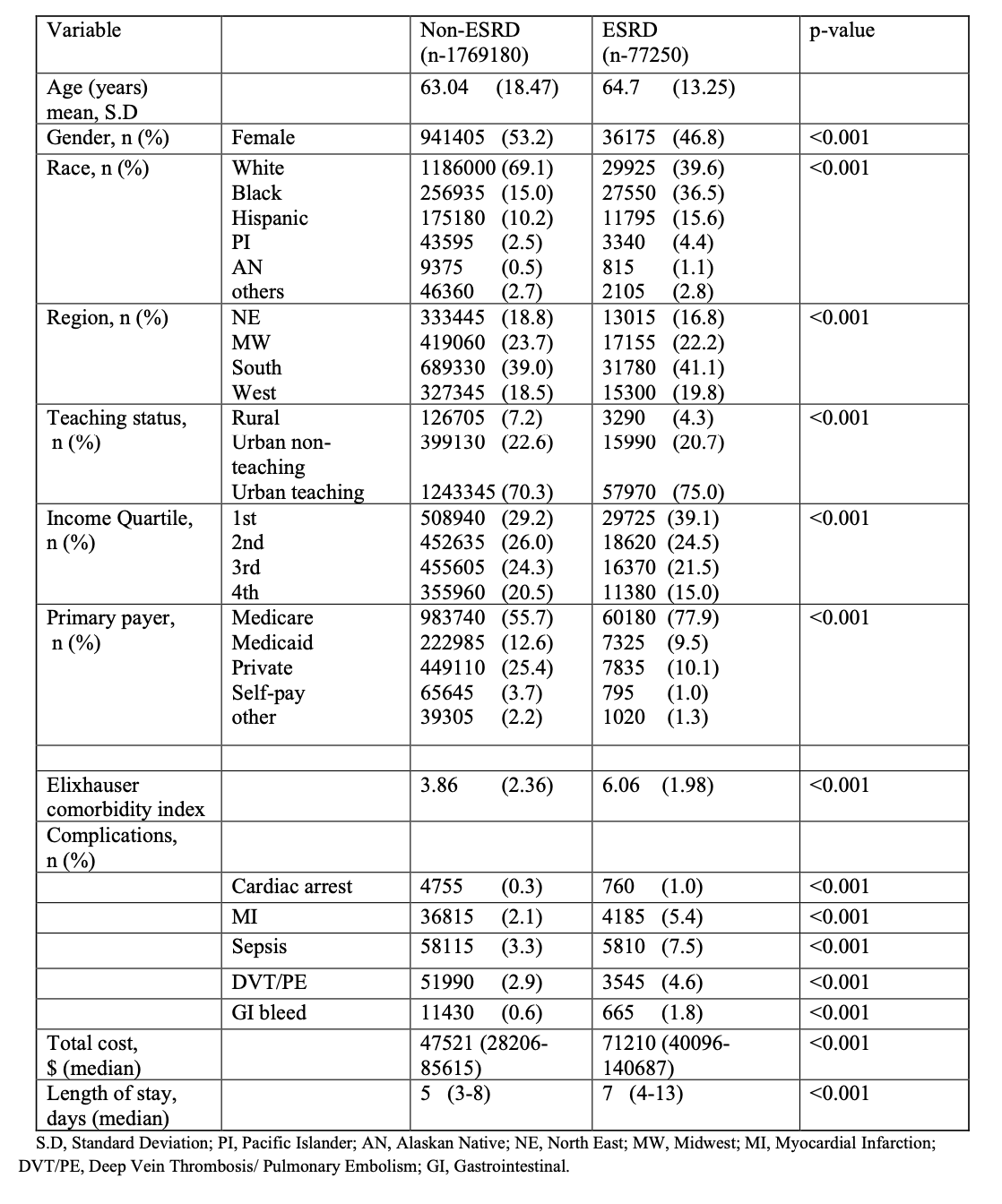Monday Poster Session
Category: Colon
P2433 - Colonoscopy Utilization and Outcomes in Patients with End-Stage Renal Disease: An Analysis of the National Inpatient Sample
Monday, October 27, 2025
10:30 AM - 4:00 PM PDT
Location: Exhibit Hall
.jpeg.jpg)
Khadija Khan, MD
LSU Health Shreveport
Shreveport, LA
Presenting Author(s)
Khadija Khan, MD1, Karan Sachdeva, MD2, Sudha Pandit, MD3
1LSU Health Shreveport, Shreveport, LA; 2LSU Health, Shreveport, LA; 3Louisiana State University, Shreveport, LA
Introduction: While colonoscopy utilization has increased in recent years, access to high-quality care and the presence of comorbid conditions such as end-stage renal disease (ESRD) remain significant barriers. ESRD may increase the risk of complications associated with colonoscopy and contribute to adverse hospital outcomes. This study aims to evaluate colonoscopy utilization in patients with and without ESRD, and to compare in-hospital outcomes between the two cohorts.
Methods: We conducted a retrospective analysis using the National Inpatient Sample (NIS) database from 2016–2019. Adult patients (≥18 years) who underwent colonoscopy were identified, and those with a diagnosis of ESRD were stratified. The Elixhauser Comorbidity Index (ECI) was used to assess comorbidity burden. Primary outcomes included in-hospital mortality, complications (including myocardial infarction [MI], sepsis, deep vein thrombosis/pulmonary embolism [DVT/PE], and gastrointestinal bleeding), length of stay (LOS), and total hospitalization costs. Statistical analyses were performed using chi-square tests for categorical variables and independent t-tests for continuous variables, with multivariable regression to assess mortality risk. Analyses were conducted using SPSS v28.
Results: Among 1,846,430 patients undergoing colonoscopy, 77,250 (4.18%) had ESRD. ESRD patients were older (mean age 64.7 years), predominantly male (53.2%), White (39.6%), and more likely to reside in the Southern U.S. (41.1%). The mean ECI score was significantly higher in the ESRD group (6.06 vs. 3.86, p< 0.001). ESRD patients experienced significantly higher rates of complications, including MI (5.1%), sepsis (7.5%), DVT/PE (4.6%), and gastrointestinal bleeding (1.8%) (p< 0.001 for all). They also had longer LOS and higher total hospital costs. Multivariable analysis showed a significantly increased risk of in-hospital mortality in ESRD patients (OR 1.65, p< 0.001).
Discussion: Colonoscopy in patients with ESRD is associated with increased procedural and systemic complications, higher inpatient mortality, prolonged hospitalization, and greater healthcare costs. These findings highlight the need for targeted interventions to mitigate risks and optimize care in this high-risk population.

Figure: Table 1: Demographics and clinical characteristics of patients that underwent Colonoscopy with or without ESRD.

Figure: Table 2: Multivariable logistical regression analysis assessing inpatient mortality between patient characteristics.
Disclosures:
Khadija Khan indicated no relevant financial relationships.
Karan Sachdeva indicated no relevant financial relationships.
Sudha Pandit: Medtronic – Product feedback.
Khadija Khan, MD1, Karan Sachdeva, MD2, Sudha Pandit, MD3. P2433 - Colonoscopy Utilization and Outcomes in Patients with End-Stage Renal Disease: An Analysis of the National Inpatient Sample, ACG 2025 Annual Scientific Meeting Abstracts. Phoenix, AZ: American College of Gastroenterology.
1LSU Health Shreveport, Shreveport, LA; 2LSU Health, Shreveport, LA; 3Louisiana State University, Shreveport, LA
Introduction: While colonoscopy utilization has increased in recent years, access to high-quality care and the presence of comorbid conditions such as end-stage renal disease (ESRD) remain significant barriers. ESRD may increase the risk of complications associated with colonoscopy and contribute to adverse hospital outcomes. This study aims to evaluate colonoscopy utilization in patients with and without ESRD, and to compare in-hospital outcomes between the two cohorts.
Methods: We conducted a retrospective analysis using the National Inpatient Sample (NIS) database from 2016–2019. Adult patients (≥18 years) who underwent colonoscopy were identified, and those with a diagnosis of ESRD were stratified. The Elixhauser Comorbidity Index (ECI) was used to assess comorbidity burden. Primary outcomes included in-hospital mortality, complications (including myocardial infarction [MI], sepsis, deep vein thrombosis/pulmonary embolism [DVT/PE], and gastrointestinal bleeding), length of stay (LOS), and total hospitalization costs. Statistical analyses were performed using chi-square tests for categorical variables and independent t-tests for continuous variables, with multivariable regression to assess mortality risk. Analyses were conducted using SPSS v28.
Results: Among 1,846,430 patients undergoing colonoscopy, 77,250 (4.18%) had ESRD. ESRD patients were older (mean age 64.7 years), predominantly male (53.2%), White (39.6%), and more likely to reside in the Southern U.S. (41.1%). The mean ECI score was significantly higher in the ESRD group (6.06 vs. 3.86, p< 0.001). ESRD patients experienced significantly higher rates of complications, including MI (5.1%), sepsis (7.5%), DVT/PE (4.6%), and gastrointestinal bleeding (1.8%) (p< 0.001 for all). They also had longer LOS and higher total hospital costs. Multivariable analysis showed a significantly increased risk of in-hospital mortality in ESRD patients (OR 1.65, p< 0.001).
Discussion: Colonoscopy in patients with ESRD is associated with increased procedural and systemic complications, higher inpatient mortality, prolonged hospitalization, and greater healthcare costs. These findings highlight the need for targeted interventions to mitigate risks and optimize care in this high-risk population.

Figure: Table 1: Demographics and clinical characteristics of patients that underwent Colonoscopy with or without ESRD.

Figure: Table 2: Multivariable logistical regression analysis assessing inpatient mortality between patient characteristics.
Disclosures:
Khadija Khan indicated no relevant financial relationships.
Karan Sachdeva indicated no relevant financial relationships.
Sudha Pandit: Medtronic – Product feedback.
Khadija Khan, MD1, Karan Sachdeva, MD2, Sudha Pandit, MD3. P2433 - Colonoscopy Utilization and Outcomes in Patients with End-Stage Renal Disease: An Analysis of the National Inpatient Sample, ACG 2025 Annual Scientific Meeting Abstracts. Phoenix, AZ: American College of Gastroenterology.
